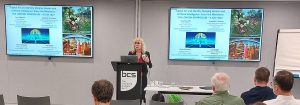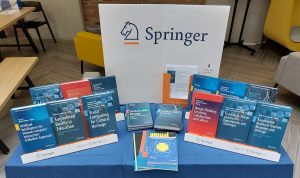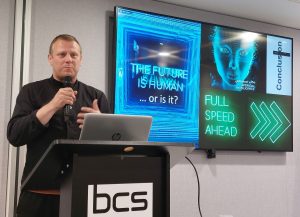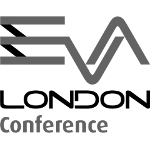
Introduction to the EVA London 2022 Symposium by Tula Giannini
EVA London 2022 Symposium
Monday, 4 July 2022
Digital Art and Identity Merging Human and Artificial Intelligence: Enter the Metaverse
See also a summary paper in the EVA London 2022 conference proceedings under DOI 10.14236/ewic/EVA2022.1
| Tula Giannini (Chair) | Jonathan P. Bowen |
| Pratt Institute
School of Information New York, USA |
London South Bank University
School of Engineering London, UK |
| giannini@pratt.edu | jonathan.bowen@lsbu.ac.uk |
| Chris Michaels | Carl Hayden Smith |
| National Gallery &
King’s College London London, UK |
Ravensbourne University London
London, UK https://www.ravensbourne.ac.uk/people-and-stories/meet-team/carl-smith |
| Chris.Michaels@ng-london.org.uk | c.smith@rave.ac.uk |
This Symposium explores themes of digital art and identity with respect to Artificial Intelligence and the developing ideas of the “metaverse”. This page provides some background to the concept of the metaverse in the context of digital culture. Then each participant provides a statement from their viewpoint and experience. These cover diverse issues based on the varied backgrounds and expertise of the contributors.
After the presentations, there will be a discussion session between the presenters and the audience, chaired by Tula Giannini.

Springer book stand
Note also that a bookstand organised by Helen Desmond of Springer is also planned, especially covering the Springer Series on Cultural Computing (e.g., see Museums and Digital Culture).
Introduction
The Symposium includes three invited speakers at the EVA London 2022 Conference. It continues a series from the previous five EVA London Symposiums held since 2016.
The Symposium series initially started in association with the Pratt Institute London Summer School, with an emphasis on digital culture and “digitalism” or “digitality”. A collaboration with the Royal College of Art developed, providing an artistic and philosophical angle to the Symposium. Aspects of digital culture continue in this year’s Symposium, which considers identity with respect to human and artificial intelligence in the sphere of digital art, and especially the advent of the “metaverse”. The speakers for this 2022 Symposium come from varied backgrounds, bringing their own perspectives to the overall theme.
The Metaverse
On 28 October 2021, Mark Zuckerberg announced by way of a burst of television advertisements that the parent company of Facebook, Instagram, WhatsApp, Messenger, and the virtual reality company Oculus is now called Meta Platforms Inc. Significantly, the advertisement begins in a museum gallery and zooms in on the jungle landscape of Henri Rousseau’s 1908 painting entitled Fight Between a Tiger and a Buffalo.
Meta’s advertisement incorporates key elements of the widely popular immersive exhibitions, especially Van Gogh. Rousseau’s painting is animated and seen through the eyes of engaged children with the implied melding of real and virtual, which in essence defines the immersive exhibition model and aesthetic sense of the metaverse to be – will that be a virtual world somewhere between digital art and Disneyland?
The only five words the advertisement contains, Zuckerberg puts into the mouth of the tiger – “this is the dimension of imagination.” So, not information, but human imagination and creativity, from which will be built a new “metaverse reality”. With digital becoming increasingly embedded in the physical world, and when seeing and being in the metaverse is realised through the digitised human body, from headsets, eyeglasses, watches, body systems to neural networks of the human and artificial brain connecting imagination and creativity, the metaverse gives us new ways of communicating states of being through digital-physical beings as robots, embedding digital systems in physical place and space. One yet to be appreciated result, is the shift away from screens in favour of direct interaction. How will this impact human digital behaviour, when the computer and smartphone, the ever-present intermediaries between humans are augmented with more integrative technology like Virtual Reality (VR) and Augmented Reality (AR)? Will digital communication and interaction become part of a new reality of living between real and virtual worlds?
This means that the field of Human-Computer Interaction (HCI) shifts its focus from human interaction with computers to human-to-human interaction within the framework of computational culture, merging real and virtual worlds, so that human interactions reside more in a simulation of real/physical life. Once the metaverse is in full swing, will life be more akin to video games and a Disneyland-like landscape? Will humans become comic-book characters? Will the metaverse be like hell on earth, or heaven in cyberspace, a new Shangri-la – or a simulation of reality, the good, the bad, and the ugly?
Each participant interprets the symposium theme in the context of their own life and work. Then looking from the present into the future, how has art, identity and human digital behaviour been transformed and what will it mean to be human in a post-Covid, post-digital world?
Speaker Statements
Jonathan P. Bowen
London South Bank University, UK
Expo 2020: Metaverse of the World?
The international Expo 2020 exhibition, delayed due to the Covid pandemic, was held in Dubai, United Arab Emirates, from 2021 to 2022. It is in itself a “metaverse” of the world with pavilions of 192 countries presenting their national characteristics in any way that they wish, within varying financial restrictions. For example, the United Kingdom pavilion included a display of poetry generated from words supplied by visitors using Artificial Intelligence (AI) techniques (see Figure 4). In contrast, the Italian pavilion included a reproduction of the historic David carved by Michelangelo, generated from a very high-resolution digital scan of the original sculpture. Other displays were more poignant with recent events, such as the Ukrainian pavilion where all electronic displays were replaced with the hashtag #StandWithUkraine.
Expo 2020 has its own associated apps, including a metaverse app paralleling the Expo 2020 site itself in a virtual world. In addition, many of the larger pavilions include large electronic displays using AI, AR, VR, and Mixed Reality (MR) approaches. The presentation covers these aspects in more detail for a selection of pavilions at Expo 2020.
Biography
Jonathan Bowen, FBCS FRSA, is an Emeritus Professor at London South Bank University, where he was Professor of Computing from 2000, and Chairman of Museophile Limited (founded in 2002). From 2007 to 2009, he was a Visiting Professor at King’s College London. In 2012, he was a Visiting Professor at the Pratt Institute in New York. He has held previous positions at Imperial College London, the Oxford University Computing Laboratory, and the University of Reading. In 1994, he founded the online Virtual Library museums pages (VLmp), later supported by the International Council of Museums (ICOM). He has been involved with the EVA London conference since the 1990s. He is also a keen contributor to Wikipedia on cultural and computing subject areas. His books include The Turing Guide and Museums and Digital Culture. He is a Life Fellow of the BCS and the Royal Society of Arts.

Chris Michaels
Chris Michaels
National Gallery / King’s College London, UK
National Gallery X – Creative R&D in a time of change
This presentation describes the story so far of National Gallery X (NGX). NGX is an innovation lab launched in 2019 by The National Gallery and King’s College London (NGX 2019). Its purpose is to experiment at the boundaries between art, media, research, and technology inside a discipline now being widely understood as Creative R&D. Over the period since its launch, NGX has experimented in areas as diverse as climate change and the representation of gender, brain-computer interfaces, artificial intelligence, and immersive exhibitions.
However, NGX’s story is also one shaped by the pandemic and our understanding – and misunderstandings – of what the future (and present) might really look like. This presentation grounds NGX and the wider growth of Creative R&D in a broader view of technology and social innovation, revealing what it really means to innovate inside public institutions.
Biography
Chris Michaels is Director of Digital, Communications and Technology at The National Gallery. He is a Senior Visiting Research Fellow at King’s College London and a Creative Industries Fellow at the UK Arts and Humanities Research Council (AHRC). He is a Bloomberg Technology Fellow and was named by Ericsson as a 5G Trailblazer. He acts as an advisor to global cultural and government organisations. He has a PhD from the University of Bristol and an MPA (Master of Public Administration) from University College London.
Carl Hayden Smith
Ravensbourne University London, UK
Exploring the Ethical Challenges of the Open Metaverse
This presentation explores the ethical challenges of the emerging open metaverse based on two projects:
- ‘Volumetric as a Service’ – with the proliferation and democratisation of volumetric capturing facilities and devices what happens to identity as we move from 2D photography to 3D point clouds?
- XPRIZE Rapid Reskilling ‘Neuro-Adaptive Mixed Reality Training platform’ (REAP technologies) – how to develop immersive XR application areas with the help of AI, Machine Learning and Sensory Augmentation.
A significant aspect of the metaverse is that it is a merging of your representation in the real world with a digital representation of yourself in the digital world. Digital twins make up the fabric of the metaverse, where the virtual and the digital are connected through a network of sensors. Already certain mobile phones with their inbuilt lidar technology can create a 3D point cloud of any environment that you are in. This has a direct impact on our privacy. When Google Glass was released, it was immediately banned in department stores as it was deemed an unacceptable invasion of privacy. Now, however, depth sensors are being built into all sorts of devices and ethical mechanisms for protecting one’s body image and possessions have not been well established. Welcome to the digital twinning of your personal context. By wearing an AR headset such as the Microsoft Hololens, you by default are generating 3D models of everything you see, this includes other people. The issue is that once your body image has been captured, it can be used, ad-infinitum in deep-fake productions.
Once Apple releases its AR headset, the impact on our behaviour will be as dramatic as when the original iPhone was released. Ethical issues will erupt because, through the simple act of looking, we will be making new realities with our eyes.
Volumetric capture studios are springing up all over the world. In light of the Covid pandemic, virtual production techniques have exploded, and the construction of the matrix is firmly underway. Frameworks for how the products of these studios should be used have yet to be formulated. The Non-Fungible Token (NFT) could be used as one way to protect your body image Intellectual Property (IP). This means you would be the rightful owner of your digital self. In this presentation we reflect on how the physical world will itself become an interface, making reality even more machine-readable, clickable, and searchable.
Biography
Carl H. Smith is Interim Head of Research, Director of the Learning Technology Research Centre (LTRC) and Principal Research Fellow at the Institute for Creativity & Technology, Ravensbourne University London. Carl has 20 years’ experience conducting R+D in the application of hybrid technologies for perceptual, cognitive and creative transformation. He is focused on using both technological and biological means to alter, probe and study the spectral nature of consciousness. His research focuses on generating new forms of media including Neuroadaptive Mixed Reality Training, Natural Media and Wearable experience (WE). Raising over £10 million in research funding, Carl has worked on numerous largescale Leonardo LifeLong Learning, Erasmus+, FP7, XPRIZE and Horizon European projects including Wearable Experience (WEKIT), REAP, AR4EU (Code Reality), Hobs Academy (LLDC), Hyperhumanism, Contextology (Context Engineering) and Holotechnica.Academy. Carl has given over 300 invited public lectures, conference presentations and keynotes in 40 countries and published more than 100 academic papers. His research interests include Embodied Cognition, Spatial Literacy, Umwelt Hacking, Sensory Augmentation, Artificial Senses and Body Hacking.
Summary
Above is an overview of the speakers’ statements with respect to digital art and identity, especially in the context of AI and in the light of the developing metaverse. The issues have been developed by the EVA London 2022 Symposium contributors from varied viewpoints. The paper acts as a starting point for the presentations during Symposium, aimed at promoting further discussion.
What kind of metaverse will be created? Surely, there will be more than one metaverse, and hopefully, there will be a metaverse created by and for digital art and artists. Although computing and technology are driving the computational framework of the metaverse, its design and aesthetic will require digital artists and designers capable of rendering a creative and innovative vision of virtual worlds.
Further online information concerning the EVA London 2022 Conference programme is available under:
http://www.eva-london.org/eva-london-2022/programme/
